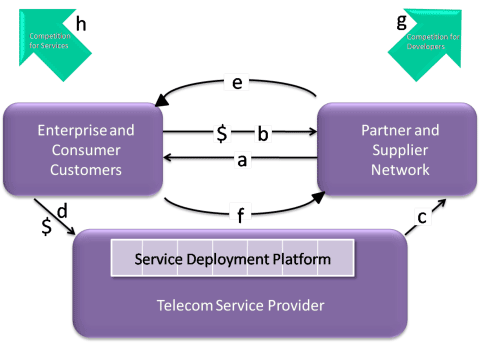
By
Chun-Ling Woon
Seeking to strike a balance between remaining within their core competencies, while still generating significant revenues, many telcos today are looking to monetize “network platform” services like billing, location-based data, and security. Aspects of the business model to accomplish this task have been explored extensively in various forums, most recently by STL Partners’ Telco 2.0 initiative. In addition, coverage by a number of other analyst firms (such as Ovum), economic papers (like Evans, Hagiu & Schmalensee’s Invisible Engine), and a new book, entitled Free, by Chris Anderson all explore the changing business model.
Upon analyzing the above sources, it appears clear that the same pattern that has driven usage growth for platforms like the iPhone, G1 (Android) and personalized and social networking services can, in theory, translate to exponential growth in telecom platform services. If this growth rate can be realized, then the “just” in “just a bitpipe” could be removed; by sharing in a fraction of a large growth curve, telcos could reap significant benefits while remaining within their core strengths.
This has not materialized to date. Why not? In matching telco’s current practices against previous rapid-growth ecosystems, there appear to be two gaps: 1) OSS/BSS’s have not allowed services to be deployed quickly nor easily enough; and 2) carriers are over-charging for platform services because they don’t fully appreciate the multi-step cross-subsidization flows in ecosystem models.
This article describes how these two gaps can be filled, overcoming important barriers to significant growth within new business models. Consider the figure below:
|
|
If this growth rate can be realized, telcos could reap significant benefits. |
|



Here, independent partners and suppliers companies create (a) products and services that they sell to enterprise and consumer customers, and for which they obtain payment (b). These partners and suppliers are experts in specific areas, such as vertical markets like health care, finance, and manufacturing, providing added value because they understand the particular, unique needs of these industries. Partner products and services use, in part, services provided by a telecom operator (c), for which they pay at most a fee to cover costs (but which some operators may choose to provide at no charge). Service providers receive the bulk of their revenues from enterprise and consumer customers who, by the nature of the communication applications they purchase, must also purchase access to the network platform from the service provider (d).
As time goes on, partners and suppliers are attracted to participating in this “ecosystem” because of their perception (e) that there is a substantial market of potential customers who use this platform and to whom they can sell. Similarly, potential customers are attracted to
|
|
|
|
| |

article page
| 1
| 2 | 3 | |
|





